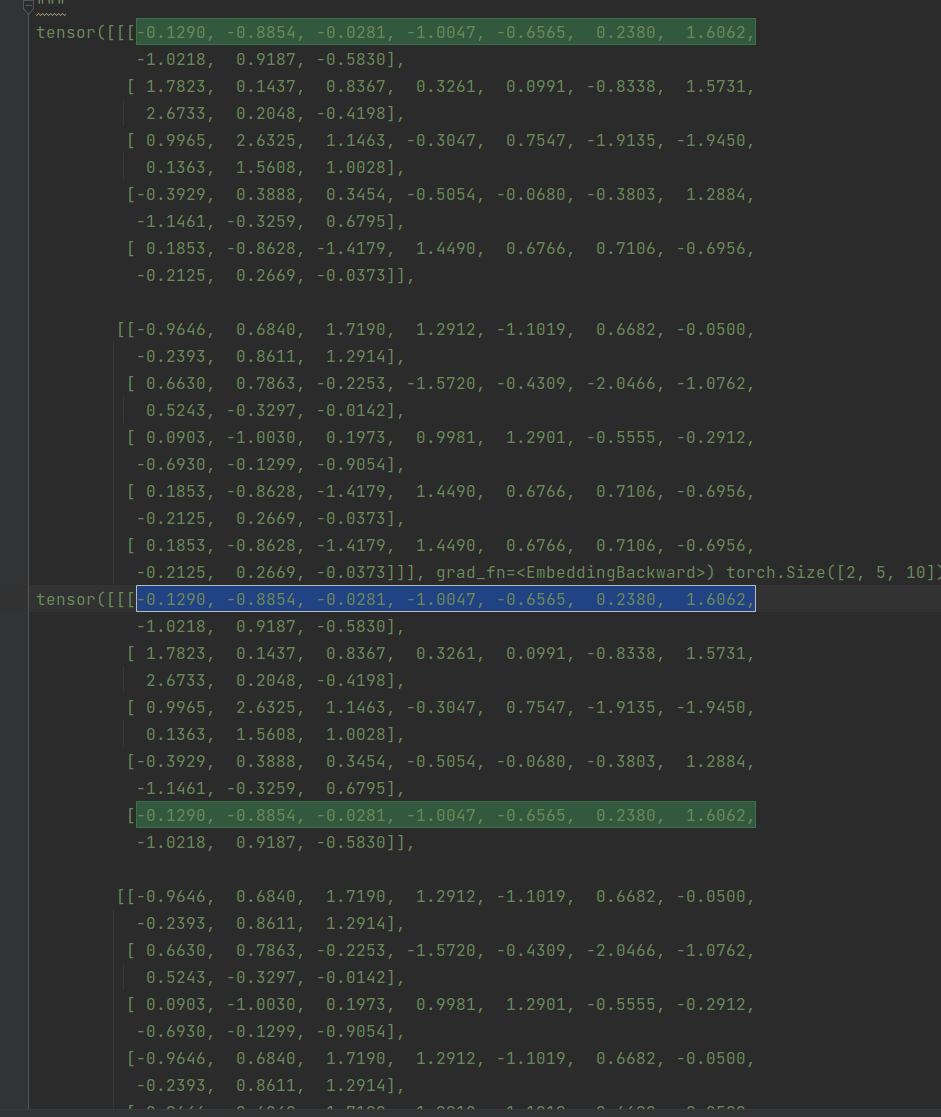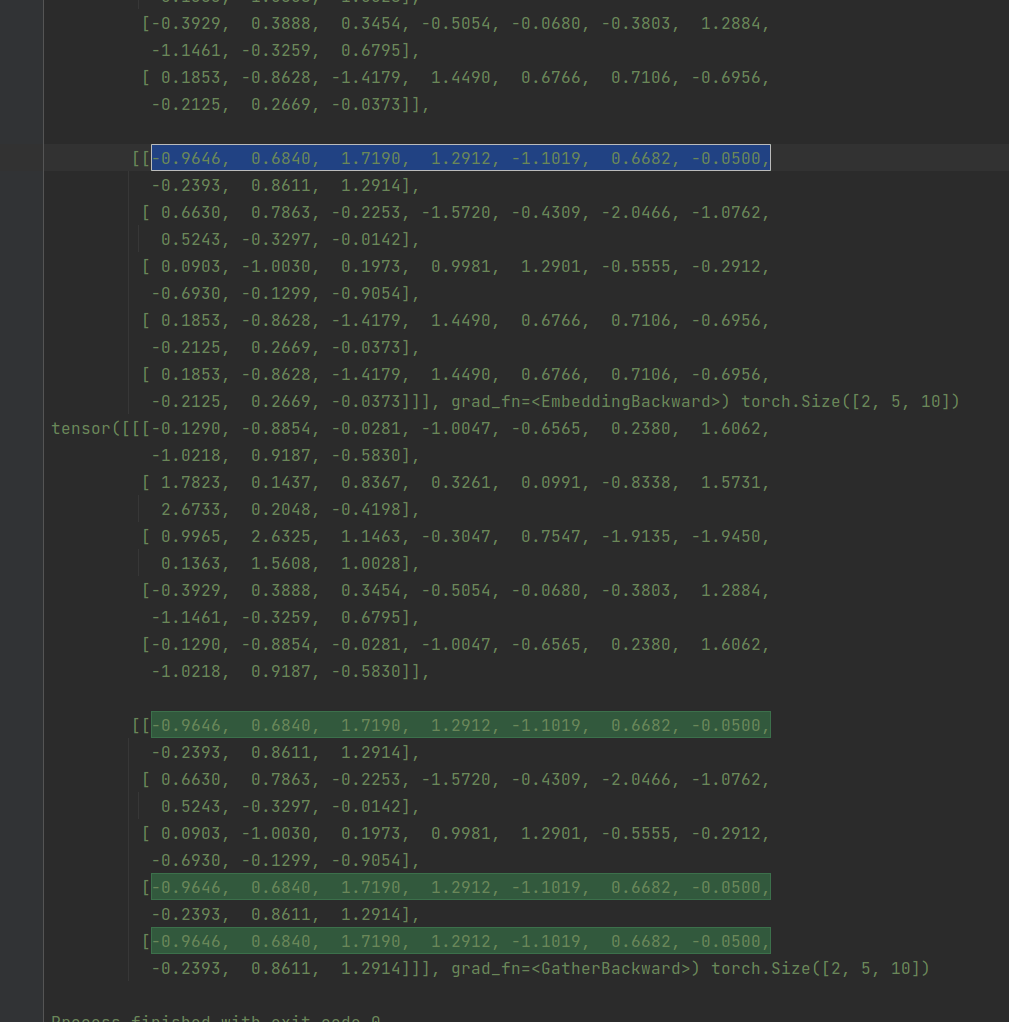1
2
3
4
5
6
7
8
9
10
11
12
13
14
15
16
17
18
19
20
21
22
23
24
25
26
27
28
29
30
31
32
33
34
35
36
37
38
39
40
41
42
43
44
45
46
47
48
49
50
51
52
53
54
55
56
57
58
59
60
61
62
|
import torch
model = torch.nn.Embedding(9, 10)
input_embed = torch.tensor([[2, 3, 4, 5, 0], [6, 7, 8, 0, 0]])
word_index = torch.tensor([[0, 1, 2, 3, 0], [0, 1, 2, 0, 0, ]])
out = model(input_embed)
print(out, out.shape)
result = torch.gather(out, dim=1, index=word_index.unsqueeze(-1).expand(-1, -1, out.size(-1)))
print(result, result.shape)
"""
tensor([[[-0.1290, -0.8854, -0.0281, -1.0047, -0.6565, 0.2380, 1.6062,
-1.0218, 0.9187, -0.5830],
[ 1.7823, 0.1437, 0.8367, 0.3261, 0.0991, -0.8338, 1.5731,
2.6733, 0.2048, -0.4198],
[ 0.9965, 2.6325, 1.1463, -0.3047, 0.7547, -1.9135, -1.9450,
0.1363, 1.5608, 1.0028],
[-0.3929, 0.3888, 0.3454, -0.5054, -0.0680, -0.3803, 1.2884,
-1.1461, -0.3259, 0.6795],
[ 0.1853, -0.8628, -1.4179, 1.4490, 0.6766, 0.7106, -0.6956,
-0.2125, 0.2669, -0.0373]],
[[-0.9646, 0.6840, 1.7190, 1.2912, -1.1019, 0.6682, -0.0500,
-0.2393, 0.8611, 1.2914],
[ 0.6630, 0.7863, -0.2253, -1.5720, -0.4309, -2.0466, -1.0762,
0.5243, -0.3297, -0.0142],
[ 0.0903, -1.0030, 0.1973, 0.9981, 1.2901, -0.5555, -0.2912,
-0.6930, -0.1299, -0.9054],
[ 0.1853, -0.8628, -1.4179, 1.4490, 0.6766, 0.7106, -0.6956,
-0.2125, 0.2669, -0.0373],
[ 0.1853, -0.8628, -1.4179, 1.4490, 0.6766, 0.7106, -0.6956,
-0.2125, 0.2669, -0.0373]]], grad_fn=<EmbeddingBackward>) torch.Size([2, 5, 10])
tensor([[[-0.1290, -0.8854, -0.0281, -1.0047, -0.6565, 0.2380, 1.6062,
-1.0218, 0.9187, -0.5830],
[ 1.7823, 0.1437, 0.8367, 0.3261, 0.0991, -0.8338, 1.5731,
2.6733, 0.2048, -0.4198],
[ 0.9965, 2.6325, 1.1463, -0.3047, 0.7547, -1.9135, -1.9450,
0.1363, 1.5608, 1.0028],
[-0.3929, 0.3888, 0.3454, -0.5054, -0.0680, -0.3803, 1.2884,
-1.1461, -0.3259, 0.6795],
[-0.1290, -0.8854, -0.0281, -1.0047, -0.6565, 0.2380, 1.6062,
-1.0218, 0.9187, -0.5830]],
[[-0.9646, 0.6840, 1.7190, 1.2912, -1.1019, 0.6682, -0.0500,
-0.2393, 0.8611, 1.2914],
[ 0.6630, 0.7863, -0.2253, -1.5720, -0.4309, -2.0466, -1.0762,
0.5243, -0.3297, -0.0142],
[ 0.0903, -1.0030, 0.1973, 0.9981, 1.2901, -0.5555, -0.2912,
-0.6930, -0.1299, -0.9054],
[-0.9646, 0.6840, 1.7190, 1.2912, -1.1019, 0.6682, -0.0500,
-0.2393, 0.8611, 1.2914],
[-0.9646, 0.6840, 1.7190, 1.2912, -1.1019, 0.6682, -0.0500,
-0.2393, 0.8611, 1.2914]]], grad_fn=<GatherBackward>) torch.Size([2, 5, 10])
Process finished with exit code 0
"""
|










发表评论 取消回复